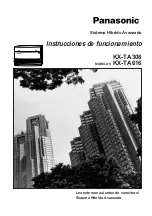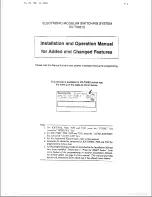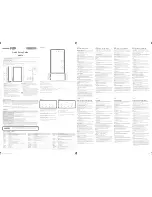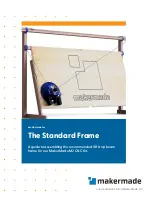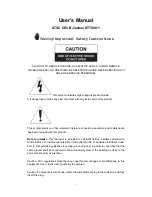
8
EASTMAN
Form C-1555
Checking the Extreme Down Position of the Sharpener
The correct down position is with the tip of the knife at the
center of the belt on the shoe (Figure 6, 12). The belt should
be in the most downward position, and the knife should be
in the most upward position. If the belts are too high, the
bottom point of the knife will not sharpen. If the belts are
too low, the bottom point of the knife will round off exces-
sively. If adjustment is necessary:
1.
Raise the belt carrier to the up position.
2.
Remove the plastic cap from the tube for the screw
shaft.
3.
Insert a pin through the hole in the tube (Figure 6, 13) to
prevent the spacer (Figure 6, 14) from turning. Then
remove the locknut (Figure 6, 15).
The following step describes the correct procedure for
setting spacer adjustment on different stroke machines:
Note:
Prior to beginning adjustment, be sure that the
spacer is threaded fully onto screw shaft.
Stroke
Turns
1-1/8"
11
1-1/4"
9
1-1/2"
13
1-3/4"
8
Note:
Each turn = 1/32"
4.
Turn the spacer clockwise with wrench C6153 to raise
the bottom position, or turn counter-clockwise to lower
the position.
Note
: One turn in either direction adjusts the position
by 1/32".
5.
Remove the locknut (Figure 6, 3).
6.
Install gauge C189 on the exposed threaded end of the
pivot screw (Figure 6, 7) and press the end of the gauge
against the side of the standard.
7.
Holding this position, engage the opposite stabilizer
(Figure 6, 4) firmly against the side of the standard and
tighten the screws (Figure 6, 2).
8.
Remove tool C189 and press the positioned stabilizer
(Figure 6, 4) against the side of the standard. Then
fasten the opposite stabilizer (Figure 6, 5) firmly against
the standard.
9.
Re-engage the back guide (Figure 6, 6) in loose contact
with the back of the standard.
Checking the Sharpener Shoes
The shoes should swing in and out freely without excessive
up and down play. If adjustment is necessary, proceed as
follows:
1.
Loosen the locknuts (Figure 6, 3) and tighten the screws
(Figure 6, 7) as required.
2.
Check the clamping arm (Figure 6, 10) with the belt
carrier in the most downward position and the knife in the
most upward position. The clamping arm should keep
the sharpener shoe from moving in. If it fails to do so,
the serrations on the clamping arm are worn or the
sharpener shoe (Figure 6, 11) is worn.
3.
Replace worn part(s) as necessary.
Содержание Blue streak II 629X
Страница 1: ......
Страница 19: ...15 FormC 1555 Figure 12 Single Phase Electrical Configuration...
Страница 40: ......






























